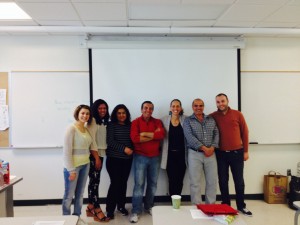Archibald J. Motley, Jr.’s Paintings: Modern Art Shaped by Precision, Candor, and SoulPosted in Articles, Arts, Literary/Artistic Criticism, Media Archive, United States on 2014-03-12 15:47Z by Steven |
Archibald J. Motley, Jr.’s Paintings: Modern Art Shaped by Precision, Candor, and Soul
Hyperallergic: Sensitive to Art & its Discontents
2014-03-09
A week ago, 12 Years A Slave won the Academy Award for Best Picture, the first time in the history of the Oscars that the top prize went to a film made by a black director. Recently, too, New York voters elected a white man who is married to a black woman; now the city’s “first family” vividly resembles the richly varied complexion of its multiracial, multiethnic population.
Against the backdrop of such belated examples of race-related “progress,” it is illuminating to flip through the pages of American cultural history and discover that almost a century ago, a black, classically trained modern artist, Archibald J. Motley, Jr., was using paint on canvas to address such nuanced subjects as the dignity of mixed-race persons and the skin-tone-based sensitivities that prevailed among his own people.
In Archibald Motley: Jazz Age Modernist, an exhibition on view at Duke University’s Nasher Museum of Art in Durham, North Carolina, the life story and achievements of this modernist innovator are receiving some much-deserved attention. Organized by Duke art history professor Richard J. Powell, whose book, Black Art and Culture in the 20th Century (Thames and Hudson, 1997; reissued as Black Art: A Cultural History, 2002), has become a standard text in its field, the Nasher exhibition will remain on view through May 11 before embarking on a US tour that will end in New York at the Whitney Museum of American Art late next year.
Motley (1891–1981), who is still not widely known today, was born in New Orleans and moved with his parents to Chicago when he was an infant. His father worked as a Pullman railway-carriage porter. After declining a scholarship to study architecture at Chicago’s Armour Institute, Archibald was accepted at the School of the Art Institute of Chicago (where, it is interesting to note, the Armour Institute’s president paid his first-year tuition fees). Motley, whose teachers included the realist painter George Bellows, went on to produce a technically inventive body of work that assimilated various stylistic developments of early-20th-century modern art…
…Powell’s implication is that Motley’s ability to view the world around him from simultaneously different vantage points and to embrace contradictions was somehow postmodernist avant la lettre. Powell pointed out, “Motley came from a part of the country, New Orleans, where mixed-race people were not uncommon. Comprehending someone whose racial identity was mixed wasn’t so hard for him but he was color-struck; he was interested in this subject and gravitated toward people like ‘the octoroon girl,’ whom he found in an A&P supermarket and who became one of his sitters.”
Powell noted that Motley was not just keenly aware of how a person’s skin color could influence his or her place in society — and the privileges or prejudices that accompany it — but like other artists and intellectuals associated with the Harlem Renaissance of the 1920s-1930s (or “New Negro Movement,” as it was known at the time), he was also interested in the multidimensional nature of black racial identity and the forms of social and cultural expression that were associated with it.
Some historians have described the light-skinned Motley, whose own ancestry was African, European and Native American, as someone who throughout his life felt unsettled about his own racial identity. As Powell sees it, the artist “instinctively understood that the issue of racial identity was complex” and therefore hard to codify, “because in his own case it was, too.” In other ways, Powell added, Motley’s life was not exactly simple or conventional, and he had to emotionally and psychologically process its vicissitudes…
Read the entire article here.

